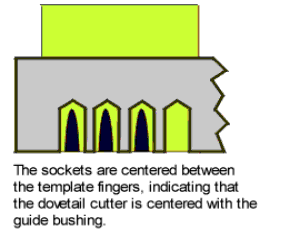|
Page Directory
Introduction
What I Like
What I Don't Like
The Bottom Line
Assembly
Setup
Making a Drawer
Tips
Guide Bushings
Stabilizer Table
Site Directory
Home
Tool Reviews
Projects & Plans
Articles
Our Shop
FAQs
Sites I Like to Visit
Build a Kayak
E-Mail Us!
Printer Friendly
Version of
this article
|
|
 Guide bushings (also known as collars or a guide bush) are extremely versatile and indispensible for many router operations. However, I have learned the hard way that guide bushings can be a source of fit problems when used with dovetail jigs, especially combination jigs like the Leigh and the AKEDA. Guide bushings (also known as collars or a guide bush) are extremely versatile and indispensible for many router operations. However, I have learned the hard way that guide bushings can be a source of fit problems when used with dovetail jigs, especially combination jigs like the Leigh and the AKEDA.
I have found two common problems with guide bushings:
- They are often poorly machined. Their diameter and out-of-center tolerances vary greatly. I have guide bushings that are .030" out-of-center!. The best bet is to purchase precision guide bushings from Leigh, AKEDA (through Woodcraft), or whomever. Leigh offers precision 7/16" and 5/8" OD bushings, AKEDA offers a 7/16" precision bushing. The 7/16" OD bushing is the most widely used bushing with Leigh and AKEDA dovetail jigs. The PC4112/PC7116 use the 5/8" OD bushing. Note that for through and half-blind dovetails, the guide diameter is not super critical on the Leigh, since fit is controlled by moving the pin template out/in (through dovetails) or by raising/lowering the bit (half-blind dovetails).
- Even if you have precise guide bushings, depending on your router, it may be difficult to center the router bit perfectly within the guide bushing. Perfeclty centering the router bit to a guide bushing is easier said than done. For instance, Porter-Cable routers mount their base to the router using flat head screws. As you tighten the screws, they center themselves in the base, drawing the base to "their center". Thus trying to center them is almost impossible. Some Bosch bases (1617 for instance) are mounted with pan-head screws, which do allow for some adjustment. However, you still may not be successful in perfectly centering the base, bushing, and bit (even with their centering cone).
 To determine whether your bit is centered in the guide bushing, simply lower the bit into the bushing, rotate the bit, and look to see whether the tips of the bit are centered within the bushing for an entire rotation. Since a dovetail bit is angled, you can lower it into the guide bushing until it barely touches--just make sure to rotate it backwards. Or, better yet, perform the following: Or, better yet, perform the following: To determine whether your bit is centered in the guide bushing, simply lower the bit into the bushing, rotate the bit, and look to see whether the tips of the bit are centered within the bushing for an entire rotation. Since a dovetail bit is angled, you can lower it into the guide bushing until it barely touches--just make sure to rotate it backwards. Or, better yet, perform the following: Or, better yet, perform the following:
- Mount the guide bushing and a straight bit in the router. The straight bit diameter must be less than the OD of the guide bushing.
- Setup your DT jig guide fingers to cut tails.
- Clamp a test board under the tail guides.
- Run the router through several guides.
- Visibly inspect the cut to determine that the cut is centered within the tail finger space. If it is centered, you're done.
- Otherwise, loosen the guide bush, rotate it 1/4 turn, and tighten it again.
- Repeat these steps until you get a satisfactory cut. You might want to mark the face of the guide bushing and router base to simplify this procedure next time around.
- If you cannot get the bit to center with the guide bush, try another guide bush. If you still have problems, you can try centering the base of the router/guide bush to the bit, but again, this is easier said than done.
- If you cannot correct the off-center problem, you might lessen the problem if you rotate the bushing so that the greatest deviation faces away from the jig (towards the operator). Then, make sure you keep the router facing the same direction as you rout the dovetails.
Wood Magazine has published a free project to build a Dovetail Jig
Stabilizer Guide. I have not built it but can express the need for such a table. R.L. Mott sent me
some photos of his stablizer table/guide. Note that RL added some T-Track to improve on the Wood Magazine design:
If you cannot access the Wood Magazine site, click here to view the article in Acrobat Reader format.
Don't discount making TD joints by hand or the hybrid method employing both the bandsaw and hand. If you're not doing a ton of TD joints, doing them by hand makes sense. If you're a novice at making TD joints by hand, buy or rent the
Dovetail a Drawer video by Frank Klausz. Actually, this video teaches alot more than just dovetails. I found his general woodworking techniques to be very enlightening.
I came up with a chart comparing the Keller, Leigh, AKEDA, and PC Omnijig dovetail jigs. Click here to view it.
Here is a run down of Dovetail jigs you might consider:
|

